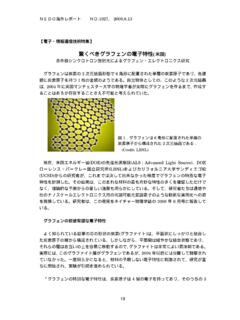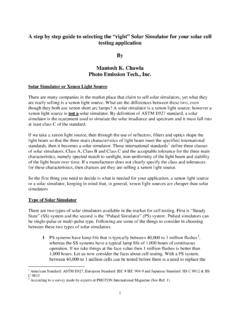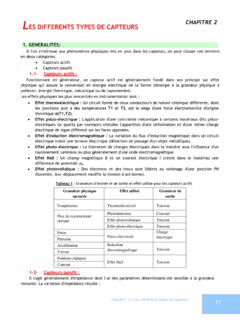Transcription of Rapid communication Work function …
1 Journal of Electron Spectroscopy and Related Phenomena 120 (2001) 149 / locate / elspecRapid communicationWork function measurements on indium tin oxide filmsa,bb*R. Schlaf, H. Murata , KafafiaCenter for Microelectronics Research,Department of Electrical Engineering,University of South Florida,Tampa,FL33620,USAbOptical Sciences Division,US Naval Research Laboratory,Washington,DC20375,USAR eceived 16 April 2001; received in revised form 15 May 2001; accepted 15 May 2001 AbstractWe determined the work function of indium tin oxide (ITO) films on glass substrates using photoemission spectroscopy(PES). The ITO coated glass substrates were chemically cleaned ex-situ, oxygen plasma treated ex-situ, or sputtered results suggest that the performance of ultraviolet photoemission spectroscopy (UPS) measurements can induce asignificant work function reduction on the order of eV, on ex-situ chemically and oxygen-plasma treated ITOsamples.
2 This was demonstrated by the use of low intensity X-ray photoemission spectroscopy (XPS) work functionmeasurements before and after the UPS measurements were carried out. 2001 Elsevier Science All rights : work function ; Ultraviolet photoemission spectroscopy (UPS); X-ray photoemission spectroscopy (XPS); Organic light emittingdiodes (OLED)1. Introductionavailable and surface modified ITO substrates byusing ultraviolet photoemission spectroscopy (UPS)Recent commercialization of organic light-emit-[1 6] and Kelvin probe (KP) [7]. Our experimentsting diodes has sparked significant interest in thefocus on the methodology of work function measure-electronic structure of the interfaces between organicments using photoelectron spectroscopy (PES) andand electrode materials.
3 Indium tin oxide (ITO) isdemonstrate that it is possible to induce significantusually used as a high work function electrode sincework function reduction by exposing ITO to the UVit combines good conductivity and transparency inlight used in UPS measurements. These resultsthe visible range. High work function electrodes arepotentially explain the differences seen between UPSused to inject holes into the organic materials, henceand KP work function measurements [7].as high as possible work function values are desir-able. A number of recent studies have been focusingon determining the work function of commercially2. ExperimentalThe photoemission experiments were performed in*Corresponding author. Tel.:11-813-974-8463; fax:11-813-974-a commercially available Omicron XP (UHV) apparatus.
4 The analysis chamber with an Omicron HIS13 high current (H. Murata), Kafafi).lamp, a SPECS RQ20 / 38 retractable X-ray gun and0368-2048 / 01 / $ see front matter 2001 Elsevier Science All rights : S0368-2048(01) et of Electron Spectroscopy and Related Phenomena120 (2001) 149 154a VSW EA 125 electron energy analyzer. The base3. Results211pressure of the analysis chamber was|5310mbar. Electrical contact to the ITO surfaces wasFig. 1 shows the low kinetic energy cut-offestablished by a small dot of silver paste at one sidemeasured on the plain ITO and ashed ITO of the sample. The 15-mm diameter samples weresamples by XPS and UPS. The spectra were normal-checked for good Ohmic contact along the , which is necessary since the UP spectra haveSample sputtering was carried out using a SPECSan|2000 times higher intensity than the XP 11 sputter gun.
5 The work function measure-It should be noted that the cut-off feature is formedments were carried out using UPS (He I, 1-mmby inelastically scattered photoelectrons, thecircular entrance slit, 5-eV pass energy) and X-rayexcitation energy has no significant influence on thephotoemission spectroscopy (XPS) (Mg Ka, 12 kV/cut-off position. Therefore, the location of the cut-off5 mA). The XPS spectra were measured at the sameis only determined by the sample work function ,analyzer settings used for the UPS its measurement at the same location withThe XPS spectra were measured with the X-ray gunany photon energy exceeding the sample workin stand by mode and retracted by 50 mm from measurement position in order to reduce theThe XPS measurements were initially conductedphoton flux and minimize the presence of stray-prior to the UPS measurements and are shown as theelectrons photoemitted from the Al bremsstrahlungbottom spectra in Fig.
6 1. The weak feature at the lowfilter window and Cu nozzle of the gun. A25-V biaskinetic energy side of the cut-offs is most likely awas applied to the sample during the measurementsresult from stray electrons coming from the Alin order to distinguish between the analyzer and thewindow and Cu nozzle of the X-ray gun, which havesample cut-offs. The spectrometer was calibrated toa lower work function than the ITO coated glassyield the standard values [8] of eV for thesubstrate. The UPS spectra are depicted in theCu3p and eV for the Cu2p(3 / 2) bindingmiddle of Fig. 1 and indicate a strong shift to lower1energy positions on an Arsputtered Cu energy, corresponding to a reduction of theAll spectra are shown in original kinetic energieswork function .
7 The work function change duringcorrected for the applied bias and analyzer workUPS measurements occurred immediately and nofunction. This allowed determination of the workgradual change could be observed by reducing thefunction values directly from the spectra by fittingexposure time to the possible minimum (1 min wasstraight lines into their low kinetic energy cut-off andthe shortest possible exposure time required for adetermining the intersect with the base line of themeasurement by quickly positioning the lamp spotspectra [9]. To account for the analyzer broadeningon the sample and running a scan across the low( eV [10]) eV was added to the workkinetic energy cut-off spectral region).
8 The XPSfunction values. All data evaluation was carried outspectra, taken after the UPS measurements andusing Igor Pro software (Wavemetrics).shown at the top of Fig. 1, confirm the UPS kineticThe ITO coated glass substrates were obtainedenergy positions. Table 1 lists the work functionfrom Planar America. One sample was sonicated invalues as derived from the spectra shown in Fig. 1deionized water, acetone, iso-propanol and finally inby the fitting procedure. The values given wereboiling iso-propanol (labeled plain ITO in thecorrected for the analyzer broadening. The linesfigures below). The second sample (labeled ashedfitted to the cut-offs shown in Fig.)
9 1 reflect thisITO ) was cleaned by hand rubbing using a It was then sonicated (5 min each) inFig. 2 shows the same set of spectra measured ondeionized water, acetone and in iso-propanol, driedan in-situ sputtered ITO sample. The insert showsin iso-propanol vapor and treated in a microwavethe full UP spectrum (on the binding energy scale)generated oxygen plasma (4 mbar, 5 min). The thirdcorresponding to the UPS cut-off. The deep valleysample (labeled sputtered ITO ) was sputtered in-between the cut-off and the valence band emissionssitu for 10 min. The sputtering conditions were 2 kV,indicates a carbon-free sample surface. This was2510mbar Ar pressure, and 13-mA emission by XPS measurements where the C 1sThe gun to sample distance was|10 region only showed a flat et of Electron Spectroscopy and Related Phenomena120 (2001) 149 154151signal, indicating that carbon related contaminationwas reduced below detection limit.
10 Table 1 showsthe corresponding work function values obtained onthis sample by XPS and UPS, which are neithersensitive to the type of measurement nor to the orderin which the measurement was 3 shows the results of a control experimentcarried out on a Pt foil that was sputtered in-situ. TheXPS cut-offs are at the same positions before andafter the UPS measurement . The calculated averagework function value of eV is in goodagreement with previously published values [11].The shoulders towards low kinetic energy are proba-bly again caused by the emissions from X-raysource. They appear stronger relative to the smallerfeatures seen in the ITO spectra, since the absoluteintensities of the Pt cut-offs were considerably data demonstrate that low intensity XPSmeasurements are capable of yielding work functionvalues of similar accuracy as those determined DiscussionIt is evident from the results shown in Fig.





